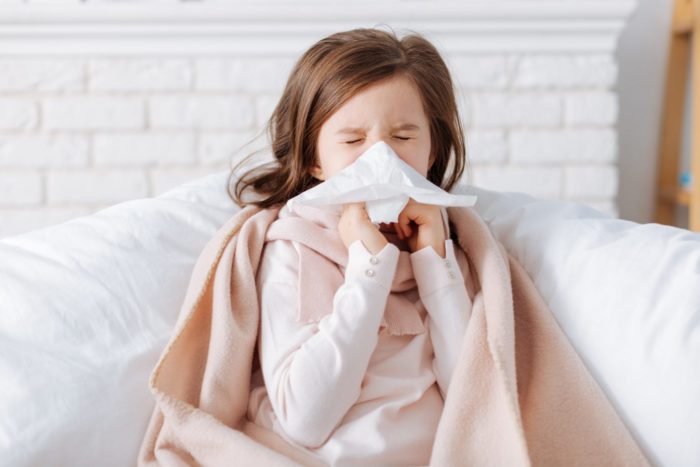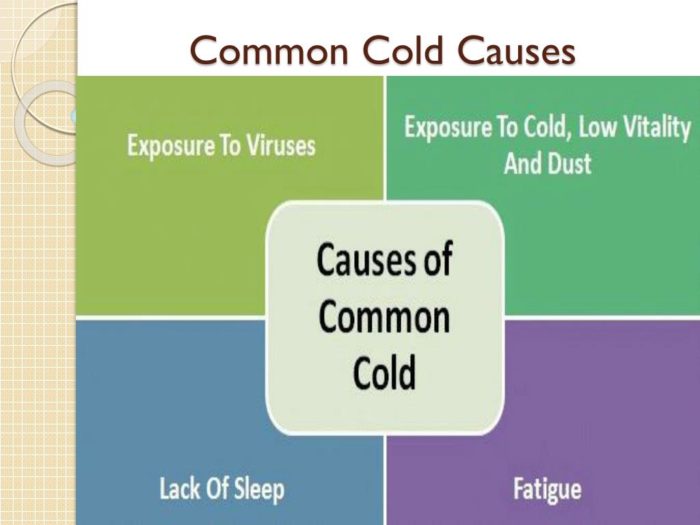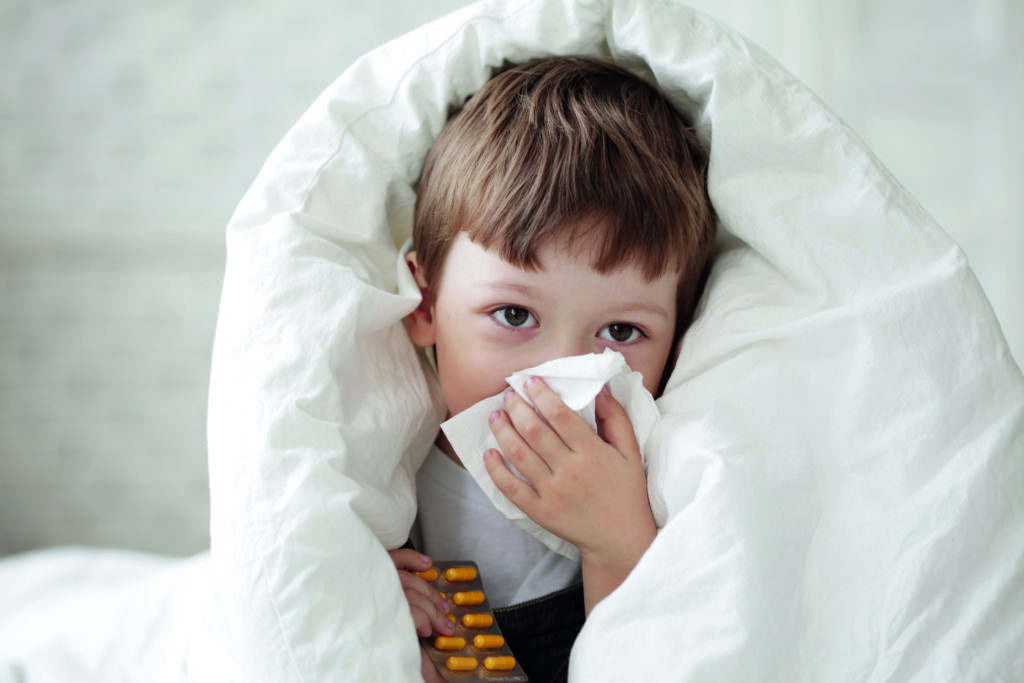Ah, the ubiquitous common cold – a frequent and oft-recurring malaise afflicting our young ones, causing disarray and vexation for both the little sufferer and their doting caregivers. A plethora of pesky viral agents can instigate this all-too-familiar ailment, with rhinoviruses reigning as the most prevalent perpetrator. Grasping the essence of colds in our youths is paramount to efficaciously managing symptomatic manifestations and adopting suitable preventive tactics.

Children’s colds typically unveil an array of telltale signs like explosive sneezing, obstructed nasal passages, raw throats, persistent coughs, head-pounding aches or mild febrile spikes. Albeit these phenomena may be agonizing for your cherished offspring, it’s vital to bear in mind that they’re generally innocuous and self-resolving. Nevertheless, discerning when an ordinary cold necessitates medical scrutiny is imperative to ensure punctual intervention should complications emerge or lurking issues demand attention.
Enacting prophylactic stratagems can substantially diminish your child’s susceptibility to succumbing to a cold. Some potent approaches encompass instructing impeccable hand sanitation rituals; fostering wholesome dietary habits along with vigorous lifestyle choices such as routine exercise and sufficient slumber – fortifying their immune defenses against invasive infections. Furthermore, staying abreast on deciphering how common cold diagnoses are made empowers parents in detecting early indicators of potential predicaments meriting swift dialogue with health care connoisseurs.
Causes and Contributing Factors for Colds
A conundrum of viral infiltration, the common cold besieges primarily our upper respiratory bastions, such as nose and throat domains. Over 200 viral variants may instigate these colds, with rhinoviruses holding the most notorious reputation. The younglings among us – children – find themselves more vulnerable to this affliction due to their nascent immune systems and propensity for close encounters with fellow youngsters in scholastic or daycare environments. Such exposure paves a facile path for transmission via acts like touching virus-laden surfaces, exchanging playthings or eating implements, or breathing in droplets from an infected peer’s cough or sneeze.

Numerous elements coalesce to augment the odds of tender-aged ones succumbing to a cold’s clutches. A child not yet six years old might endure up to eight annual bouts of cold as their fledgling immune system grapples with diverse viruses onslaught. Environmental aspects too wield influence over susceptibility; colder climes often drive individuals indoors where proximity permits germs’ proliferation. Furthermore, stressors and slumber deprivation can debilitate our organic bulwarks against maladies.
Parents and caregivers ought vigilantly discern symptoms indicative of colds so they may proffer fitting care when requisite. Common manifestations encompass runny or congested nasal cavities, raw throats, coughing fits, sneezing salvos, mild fevers and pervasive lassitude. While no panacea exists for the common cold itself (attributable to its viral essence rather than bacterial invaders which could be vanquished by antibiotics), treatment concentrates on assuaging these symptoms whilst permitting your offspring’s physique time recuperate organically . Over-the-counter potions like decongestants antihistamines might offer some respite but must always be employed judiciously under pediatrician oversight particularly regarding infant toddler cases\n
Recognizing Symptoms and Signs of a Cold in Your Child
Discerning the manifestations of a ubiquitous cold in a youngster is vital for guardians, as it empowers them to respond fittingly and offer indispensable consideration. Colds among little ones are an ordinary malady they face, and albeit generally innocuous compared to other wellbeing concerns, it can still provoke uneasiness and misery. Manifestations usually comprise of a runny or blocked nose, scratchy throat, hacking, wheezing, gentle feverishness, throbbing head or body. These indications are comparable for both young ones and grown-ups; however, some chilly signs might be more extreme or drawn out in youngsters.
It is crucial for guardians to intently watch their kid’s state when they think somebody with a cold has been near them. Considering that infections causing the omnipresent cold are profoundly infectious and simple for kids to transmit among one another by touch or through respiratory beads from hacks and sniffles. Guardians ought likewise to focus on any conduct modifications or hunger changes that could suggest an issue beyond just an uncomplicated cold. With older children who can express their sentiments better than younger ones may have grumblings about feeling depleted or experiencing issues dozing because of stuffiness.
To guarantee appropriate care during this period of sickness in your child’s life make certain your youngster gets abundant rest by urging naps throughout the day if necessary along with supporting hydration by providing copious liquids like water juice broth soup etc., which will help reduce some distress caused by these manifestations moreover keep close supervision over any possible complexities such as ear contaminations sinusitis bronchitis pneumonia asthma intensifications among others since early mediation assumes an essential part overseeing seriousness development recuperation course treatment plan eventually counteraction future episodes related medical issues
Prevention Strategies to Reduce the Risk of Colds
In the perplexing realm of common cold prevention, one must circumnavigate the treacherous waters of viral contact minimization. The crux lies in comprehending that for a child to be bestowed with said cold, an unfortunate rendezvous with the virus is inevitable. As colder months entrap our offspring within confined spaces, their interactions become more intimate and bursting with opportunities for minuscule viral exchanges during playtime escapades.
To mitigate this risk factor, it is imperative that your progeny adhere to exemplary personal hygiene rituals – frequent hand ablutions and evading close encounters with symptomatic individuals are paramount.
A secondary yet equally vital component encompasses fortifying your child’s immune system defenses, enabling them to valiantly battle infections. Ensuring they indulge in ample slumber, consume a harmonious diet brimming with fruits and vegetables, partake in consistent physical exertion, and skillfully manage stress contributes significantly towards maintaining a robust immune system fortress. Nevertheless, bear in mind that despite these precautionary endeavors being deployed into action; on average children will succumb to at least 8 colds annually due to their evolving immunity systems.
Alas! A cure for the ubiquitous common cold remains elusive; however numerous treatment alternatives exist which can assuage symptoms and expedite recovery once infection has infiltrated its victim. Parents’ focus should remain steadfast on alleviating their child’s discomfort as they weather through the illness whilst ensuring age-appropriate safety measures are observed. Over-the-counter remedies may be cautiously employed upon consultation with esteemed healthcare professionals or pharmacists who shall bestow guidance regarding apt dosage parameters based on age and weight constraints—thereby guaranteeing relief without inadvertently inducing complications resulting from improper utilization or potential adverse reactions from adult-oriented medications alone.\n
Diagnosing a Cold: When to Consult a Doctor
Parents must be ever watchful in overseeing their offspring’s well-being, for the young ones are prone to acquiring sniffles with greater frequency than grown-ups. The ubiquitous cold ranks high among maladies that beset children, many of whom suffer its grip annually or even multiple times within a year before reaching their second birthday. This heightened vulnerability owes itself to immature immune systems and rampant germ exposure during mingling with peers. Should your progeny mingle with an infected individual or exhibit signs of a fresh cold soon after recovering from one, it might be prudent to seek medical counsel.
Identifying a cold typically entails evaluating the symptoms manifesting in your child. These indicators often persist for 1-2 weeks and may encompass fever, coughs, sneezes, sore throats, runny noses, and congestion. A pivotal factor doctors ponder during diagnosis is whether your child inhales air tainted by any of the myriad viruses culpable for inciting common colds. It is imperative for guardians to impart proper hygienic practices such as handwashing and evading close encounters with those afflicted by contagious maladies since contracting a cold poses little challenge for youngsters due to their nascent immunity.
In certain instances where store-bought cough remedies prove inefficacious or when symptoms exacerbate rather than ameliorate after several days have elapsed, soliciting professional medical wisdom becomes requisite. A healthcare practitioner will ascertain if any latent conditions necessitate further intervention beyond customary care efforts aimed at alleviating your child’s discomfort whilst recuperating from this prevalent affliction amongst youth.
Treatment Options for Alleviating Cold Symptoms in Children
Amidst the chilly embrace of winter months, younglings often congregate indoors and unwittingly trade more than just stories. The frequent adult ailment known as a cold appears rather commonplace in such circumstances. Germs spread surreptitiously through close encounters of the playful kind, where several children partake in boisterous games.
One must bear in mind that signs of a cold emerge mysteriously between 1-3 days post virus exposure, rendering it challenging to trace your child’s specific moment of contact with the invisible foe. Symptoms may occasionally deviate from expected manifestations in adults since children navigate their recuperation from colds along distinct paths.
In addressing your offspring’s telltale signs of a cold, be aware that they might masquerade as graver concerns initially. Nevertheless, oftentimes these symptoms yield to unpretentious home concoctions or over-the-counter (OTC) elixirs readily available at apothecaries. It is vital not to dispense OTC cough and cold potions on little ones below four winters without seeking counsel from medical sages first due to lurking perils therein. For elder progeny granted permission by physicians or pharmacists alike, age-appropriate doses grant reprieve from discomfort whilst hastening their return to health.
Moreover, parents ought not underestimate how effortlessly one’s child can contract this malady via floating droplets or tactile engagement with tainted objects like playthings or door handles. To diminish chances for infection amidst siblings or comrades immersed in lively indoor amusements together, contemplate introducing safeguarding practices encompassing regular hand cleansing and periodic sterilization of mutual belongings. Pursuing these measures alongside apt treatment alternatives for alleviating your child’s cold symptoms swiftly when required shall ensure they rebound promptly while curtailing disturbances within familial existence during those unavoidable episodes of indisposition.
The Role of Over-the-Counter Medicines in Managing Colds
In the realm of bewildering colds, particularly for youngsters who endure one after another throughout the frosty season, over-the-counter (OTC) remedies prove to be vital players. Given that antibiotics are powerless against viral infections like common colds, treatment seeks primarily to alleviate symptoms until your little one regains their vigor. OTC concoctions offer respite from myriad afflictions such as feverish heat, stuffed passages, and relentless coughing.
It is imperative to recognize that with age comes reduced susceptibility to colds; however, viruses afflicting older children and grown-ups may yet plague them. In procuring an OTC elixir for your offspring, selecting age-appropriate brews and meticulously adhering to dosage guidelines is of utmost importance. Additionally, parents must remain vigilant regarding potential side effects or clashes with other potions their child might be consuming.
Employing over-the-counter medicines can indeed effectively dull symptoms until your youngster feels rejuvenated; nonetheless, remember that preventative tactics such as hand cleansing and evading proximity with those diagnosed with a common cold remain crucial in diminishing virus-catching risks. Furthermore, bear in mind that if your child’s ailments persist or worsen despite OTC treatments’ employment or if you harbor concerns about their well-being at any juncture during their sickness bout – seeking counsel from a healthcare sage for further direction on managing their ailment is always paramount.\n
Adapting Care for Different Age Groups: From Infants to Older Children
Tending to the little ones with sniffles and sneezes entails an approach divergent from that employed for grown-ups, given their nascent immunity still blossoming and potentially lagging in combating pesky invasions. Comprehending the disparity between what benefits both minors and majors is paramount since it may trigger unfavorable repercussions among the tender-aged populace. For example, readily available potions for colds generally ought not to be dispensed to infants or younglings without seeking counsel from a healthcare savant initially.
As progeny advance in age, certain curatives might prove more fitting for alleviating their maladies. Albeit imperative not to utilize these concoctions on children below four years sans medicinal direction, some over-the-counter elixirs could serve those above half-a-year old. Nevertheless, guardians must perpetually adhere to prescribed quantities and liaise with a child specialist before bestowing any remedy upon newborns or tots who have yet to cultivate thorough resistance against familiar ailments.
One must recognize that scholars of school-going maturity may contract as many as 10 colds per annum due primarily to augmented interaction with fellow humans amidst learning institutions and ancillary pursuits. Ergo, caregiving tactics should emphasize prophylactic actions such as hand cleansing and segregating sickly offspring from hale counterparts when feasible. If required, caregivers can dispense fitting OTC frigid treatments specially crafted for this demographic but eschew aspirin-laden products owing to its linkage with Reye’s Syndrome – an uncommon yet grave affliction impacting mainly youthful beings aged 4-14 during viral infestations akin to influenza or varicella-zoster virus manifestations.

